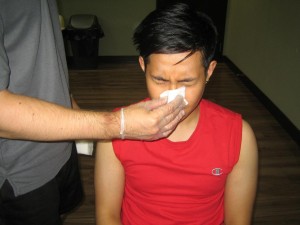Even though nosebleeds are quite common, most often they are considered as a nuisance and not an actual medical condition. Nevertheless, it can be both. Some children usually panic once they have a nosebleed while adults end up distressed during the condition, thus it is important to be familiar with the appropriate first aid care.
How to take care of a nosebleed
The first aid care for a nosebleed is relatively simple and if a family member or friend experiences one, you can provide the right care.

- Position the individual by sitting upright and lean forward – By sitting upright, it helps minimize the blood pressure in the veins of your nose, thus preventing further bleeding. By leaning forward, it helps avoid the swallowing the blood that can irritate the stomach.
- Pinch the nose – With your thumb and index finger, pinch the nostrils close and instruct the individual to breathe using the mouth. Continue to pinch the nose for 5-10 minutes. This will send pressure to the bleeding point and usually stops the flow of blood.
- Prevent repeat bleeding by instructing the individual to avoid picking or blowing the nose as well as bending down for extended periods after the bleeding episode. At this time, the individuals should always maintain the position of the head higher than the heart.
- In case bleeding occurs again, you have to instruct the individual to blow out forcefully in order to clear the nose from blood clots. Spray both nostrils with a decongestant nasal spray that contains oxymetazoline. Pinch the nose again and get in touch with a doctor.
When to seek medical care
There are also cases of nosebleed that would require immediate medical care.
- If the bleeding persists for more than 20 minutes
- The nosebleed episode occurred after an accident, an injury to the head or a fall including a punch on the face that resulted to a broken nose.
When to contact your doctor
- You experience nosebleeds frequently. If this is the case, a blood vessel requires cauterization. This is a method in which the blood vessel is burned using an electric current, laser or silver nitrate. Your doctor will usually pack your nose with a special gauze or inflatable latex balloon to apply pressure on the blood vessel as well as stop the bleeding.
- You are experiencing nose bleeding and currently taking blood thinners such as warfarin or aspirin. Your doctor will usually adjust the dosage of your medications.
Individuals who are utilizing supplemental oxygen that is administered via a nasal cannula or tube are at risk for nosebleeds. It is best to apply a lubricant that is water-based to the nostrils as well as increasing the humidity in order to help relieve nose bleeding.
First aid for nosebleed should be part of the first aid training in the workplace. In doing so, individuals who are suffering from a nosebleed will be given appropriate care right away.

